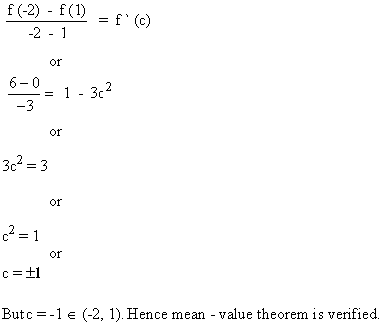|
Example 14
Verify that f (x) = ex sin
x satisfies the hypothesis for the Rolle’s theorem on [0, p]
and find number c described in the theorem.
Solution : f (x) = ex
sin x is continuous on [0, p]
and differentiable in (0, p)
Also, f (0) = f (p) = 0
\ All
the conditions of the Rolle’s theorem are satisfied.
\ There
exists a x = c Î(0,
p) such that f ' (c) = 0
Now f '(x) =
ex cos x + ex
sin x
= ex
(cos x + sin x)
\
f '(c) = ec (sin c + cos c)
\
0 = ec (sin
c + cos c)
OR sin c + cos
c = 0 Þ tan
c = -1 Þ c
=  Î(0,
p).
Î(0,
p).
Hence the Rolle's theorem is verified.
Example 15
Verify Mean-value theorem for x - x3
in (-2 , 1)
Solution : f (x) = x - x3
\ f
'(x) = 1 - 3x2
\ f
(x) is continuous on [ -2, 1] and derivable in (-2, 1) and
f (-2) = -2 + 8 = 6 and f (1)
= 1 - 1 = 0
All conditions of L.M.V. theorem are satisfied.
\
There exists one x = c in (-2 , 1) such that

[next page]
|